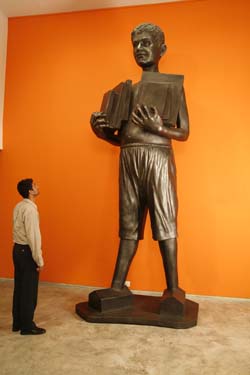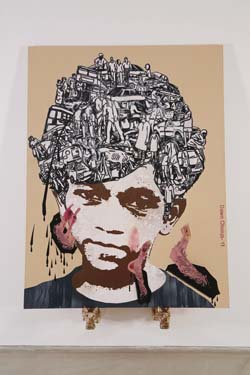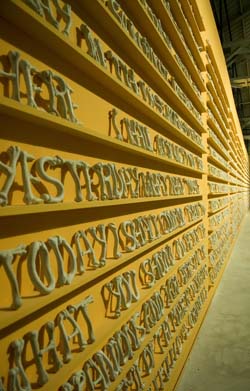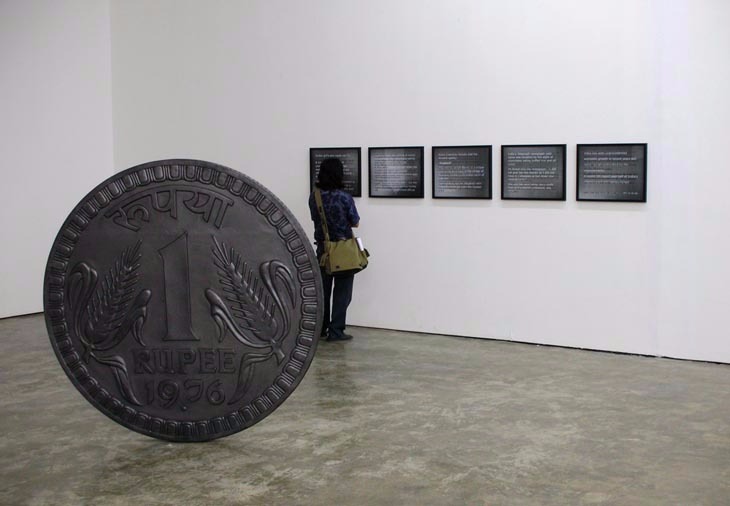
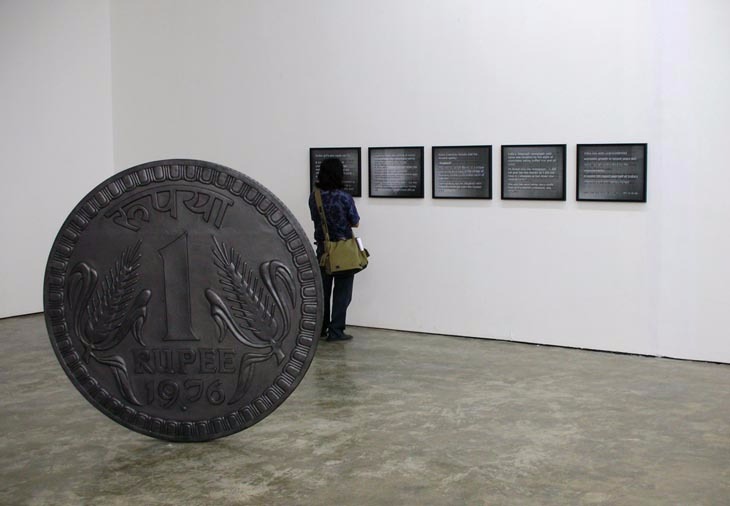
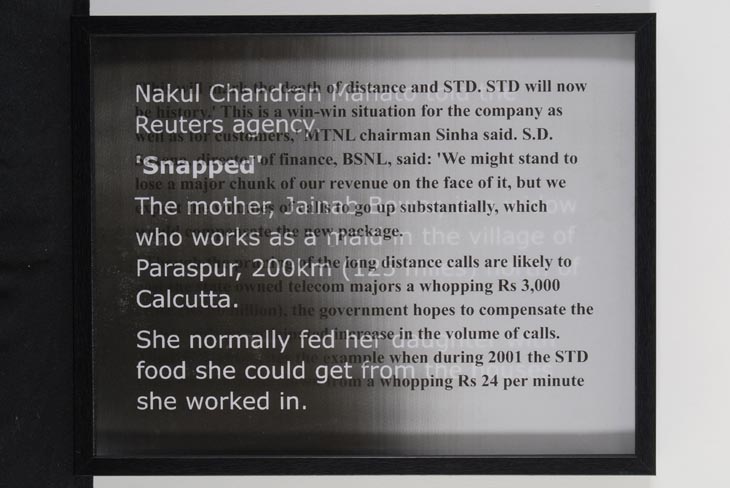
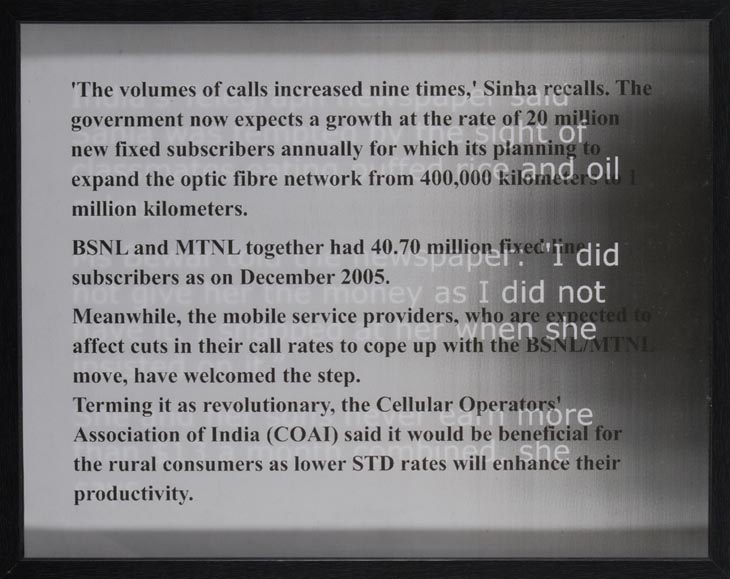
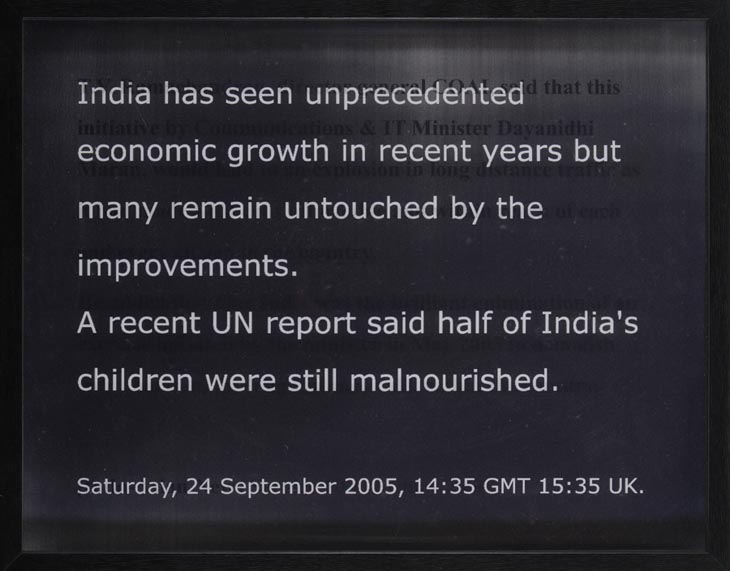
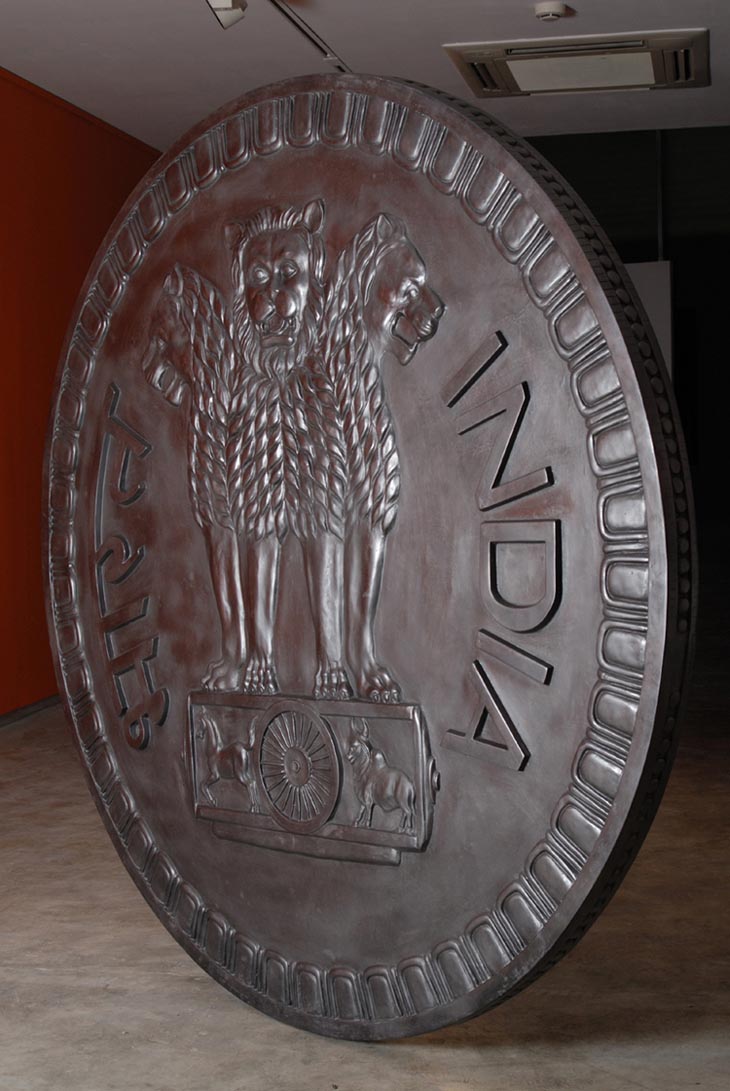
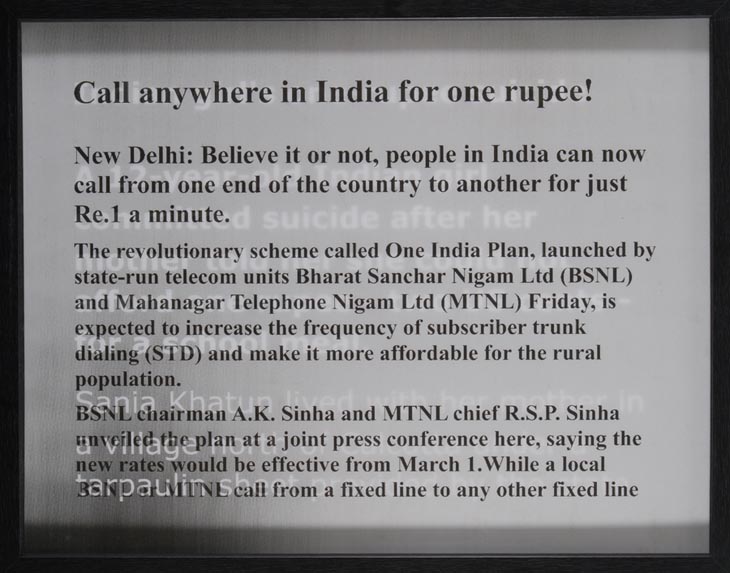
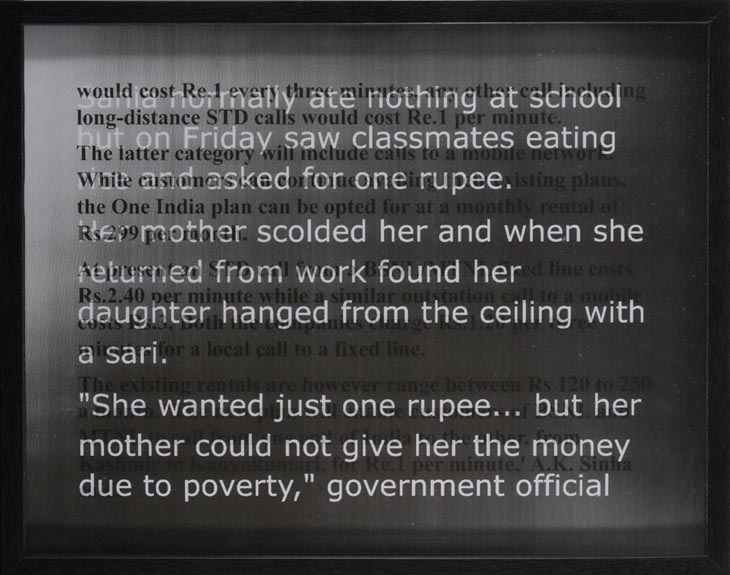



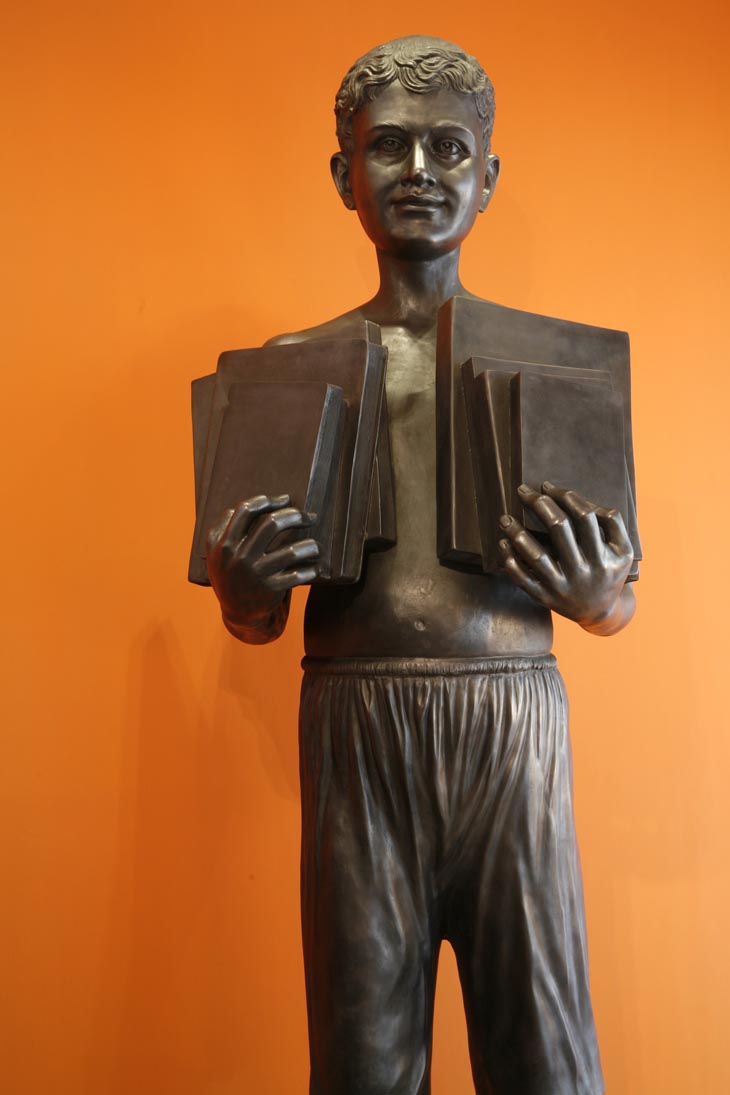
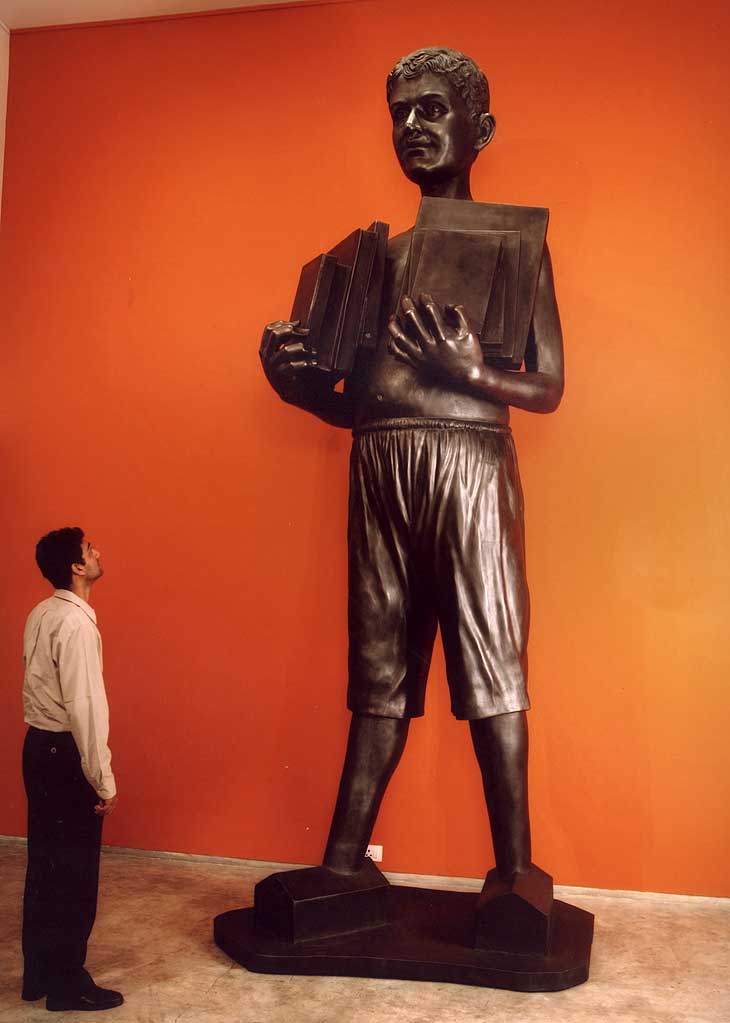
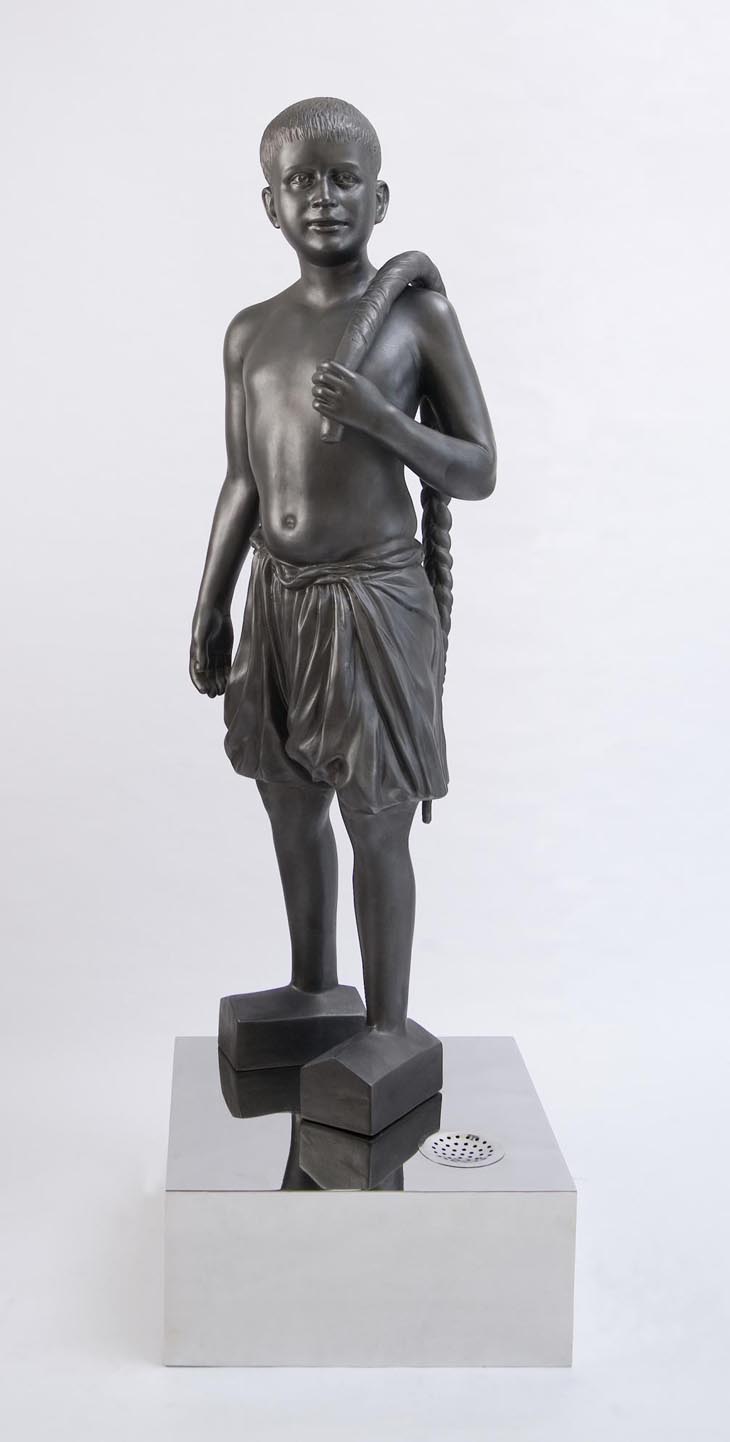

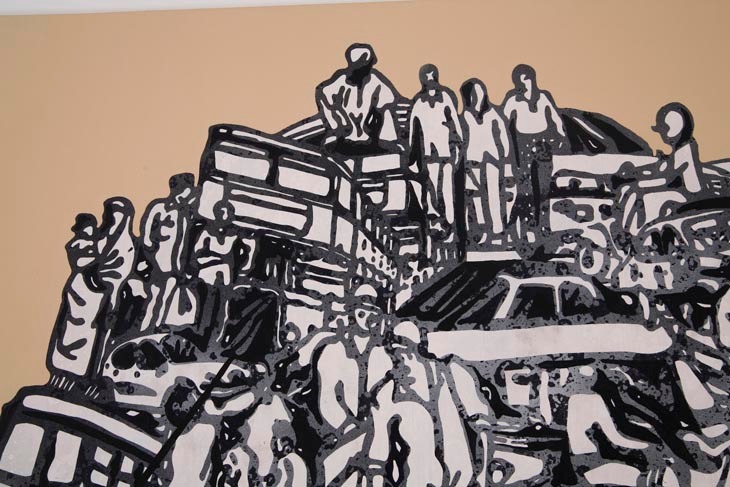

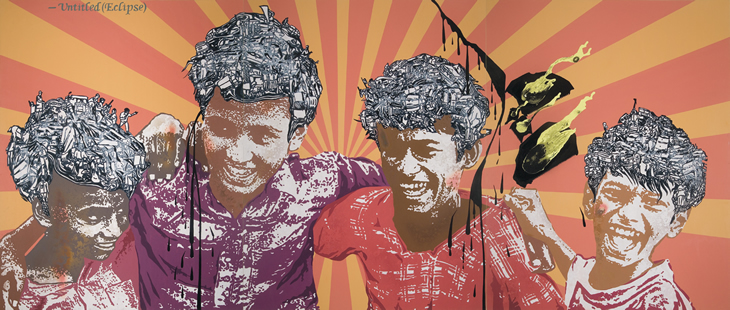

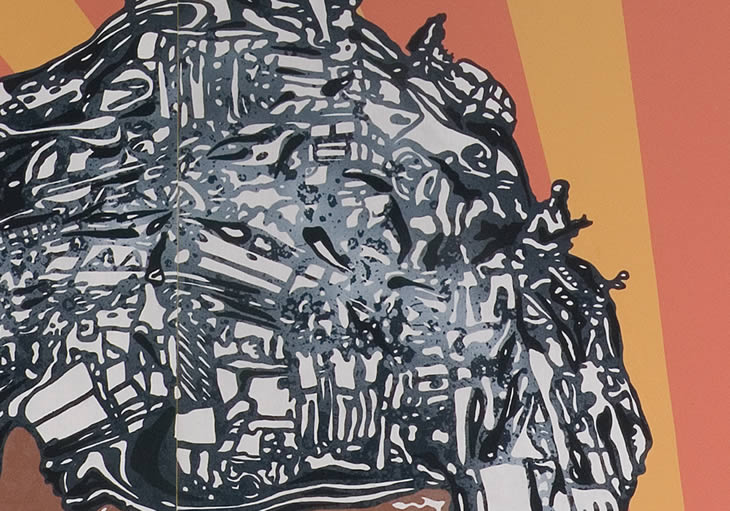
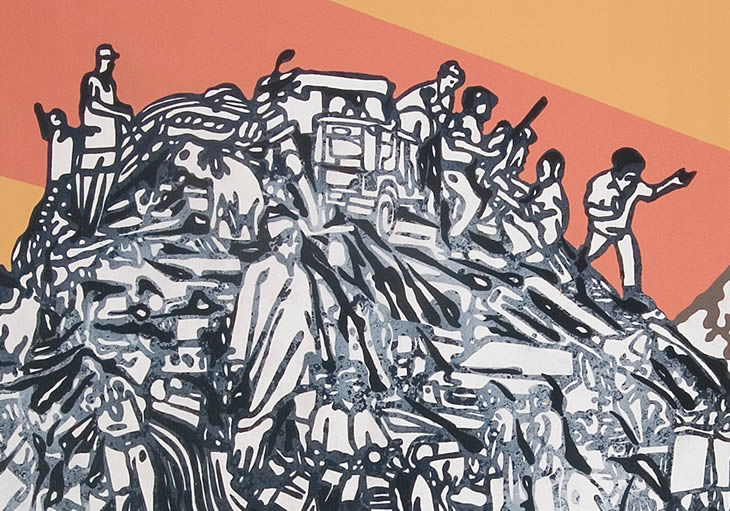
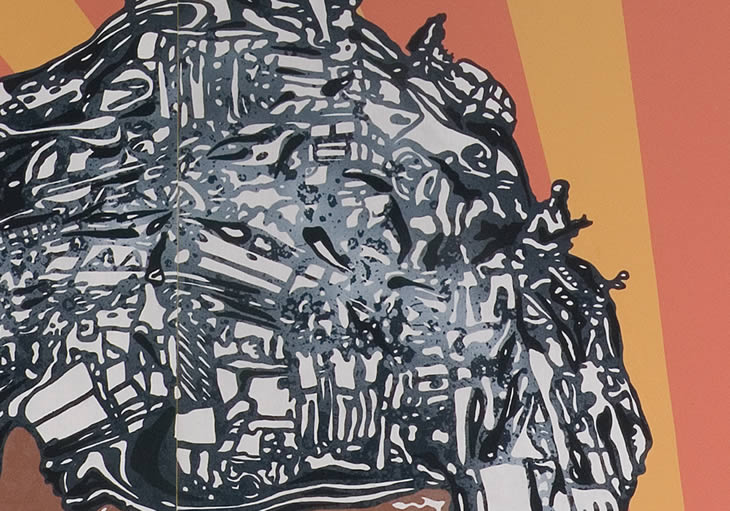

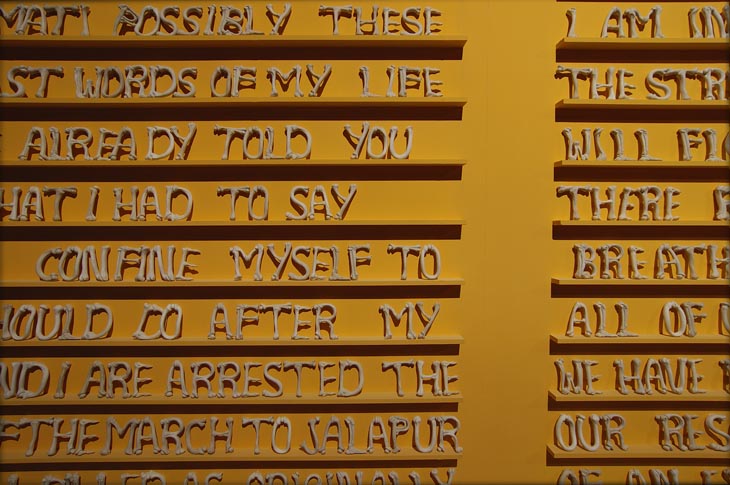
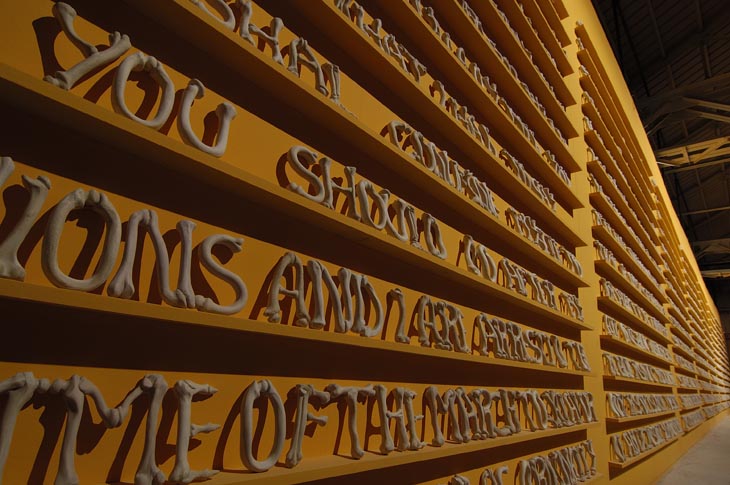
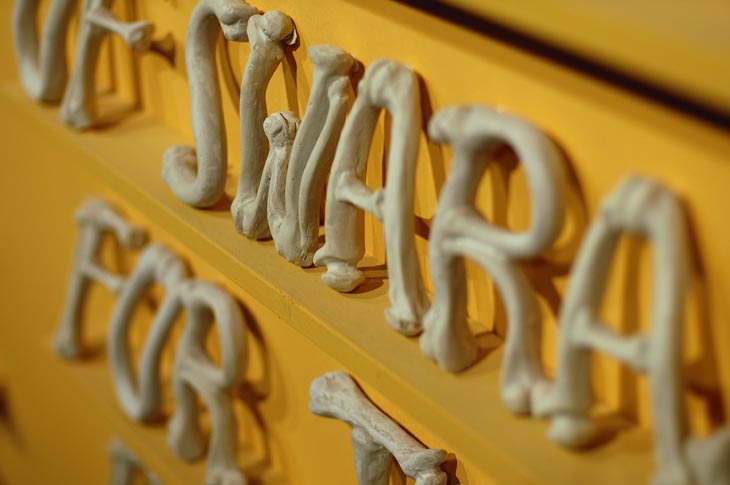
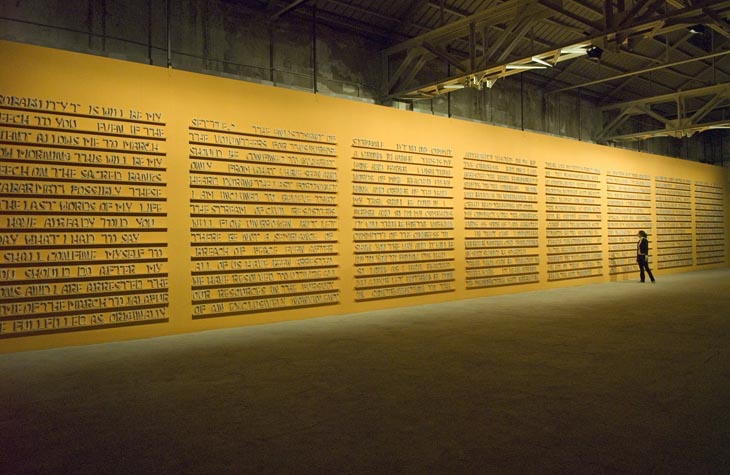
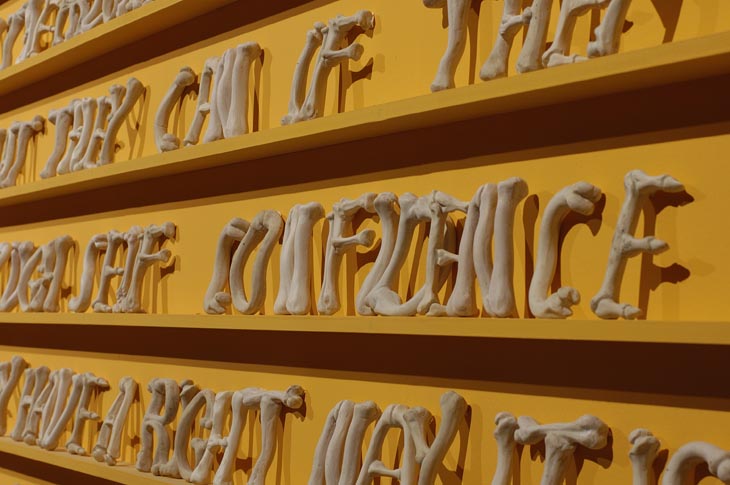
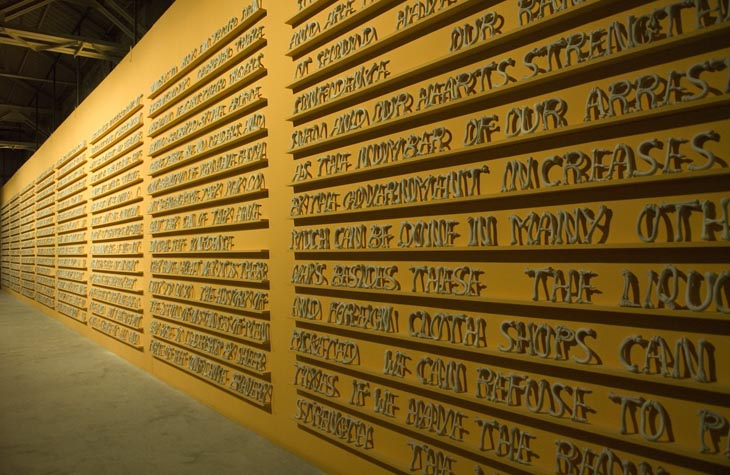
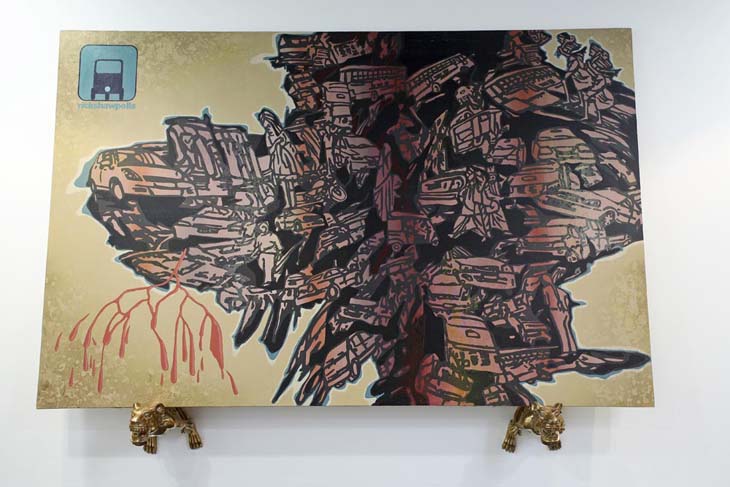
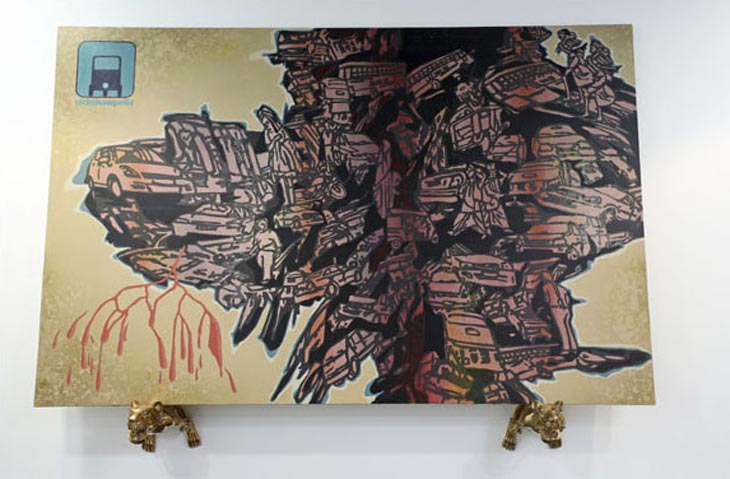
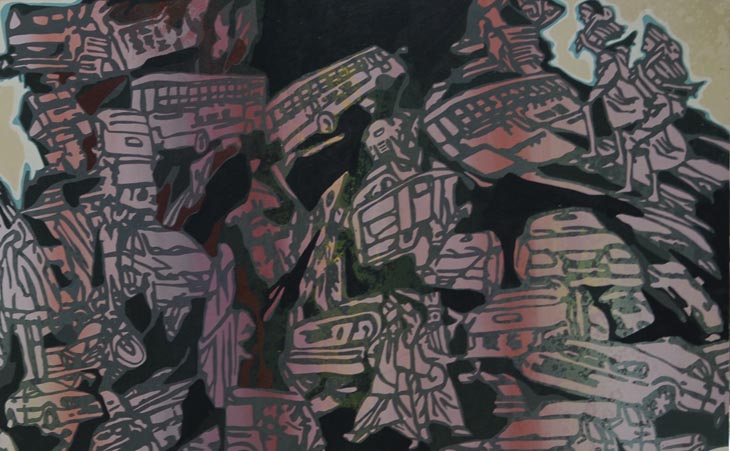
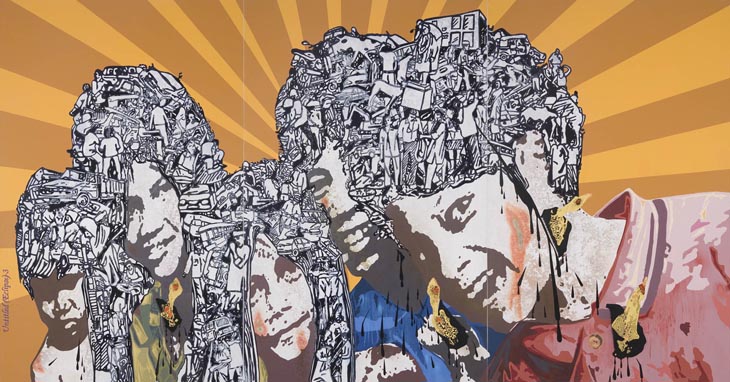
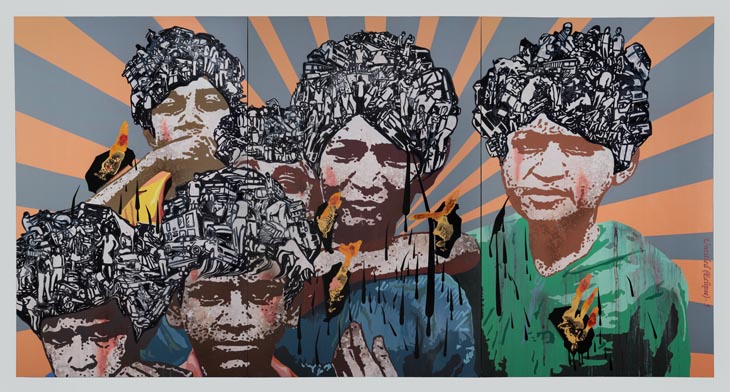
Jitish Kallat
In Death of Distance five lenticular prints bring together contrasting experiences of living in India today. Each of the panels highlight two divergent news stories; the launch of ‘one rupee a minute’ telephone rates across India and a disturbing story of a girl who committed suicide because her mother couldn’t afford the one rupee she wanted for a school lunch. A rigid rupee coin is balanced on the gallery floor, while the two narratives flip and interchange depending on the position of the viewer.
Eruda is a mammoth iconic sculpture of a young boy selling books on the traffic lights of Mumbai. The children (who could sometimes be illiterate) often sell these books authoritatively, playfully engaging in conversations about the book’s interest value; their rigour, audacity and endurance making them mascots for the resilience of a city such as Mumbai. Kallat’s sculpture has feet shaped like homes, forming the quintessential image of a nomad whose home is where he lays his feet. Treated in black-lead, ‘Eruda’ ensures that you take back a black stain on your fingers if you choose to touch him; also black-lead is the softest form of carbon while diamond remains the hardest.
Annexe is a sculpture of a young child, whose upstanding posture suggests a determination to survive. Weighing over his shoulder is a heavy serpentine rope used as a whip with which to lash himself in order to seek alms. Like Eruda, his feet shaped like homes appear rooted to the spot while his glistening black-lead body stands on a stainless steel base with a drain, perhaps representing a punctured sculpture pedestal or the societal gulf between the veneer of wealth and the perceived stain of real poverty. Much of Kallat’s work appears to deal with Mumbai’s dislocated and downtrodden inhabitants. In his canvases, faces are illuminated by animated collages that rest precariously over their heads like overbearing wigs containing scenes of the underbelly of the industrial city. Kallat mounts these animated portraits onto bronze gargoyles that are reproduced from the Victoria train terminus in central Mumbai. The Untitled (Eclipse) 2008 series takes on a more pressing significance when elevated upon these replica gargoyles, as the portraits become emblems and epitaphs to these animated lives. Within my practice, ’Public Notice 2’ (2007) links up with two key antecedents, ’Public Notice’ (2003) and ’Detergent’ (2004), both works wherein a historical speech is summoned as the central armature of the work. Blurred and sometimes forgotten due to the passage of time, the historical speech is fore-grounded and held up as an apparatus to grade our feats and follies as nations, as humankind.’Public Notice 2’ (2007) re-invokes the momentous speech delivered by Mahatma Gandhi on the eve of the historic 400-kilometer ’Dandi March’ lasting about 24 days during the Indian Freedom Struggle. On the 11th of March 1930, prior to setting out to break the brutal Salt Act instituted by the British, Gandhi laid out the codes of conduct for his fellow revolutionaries. He called for complete ’Civil Disobedience’; the only fierce restriction being that of maintaining ’total peace’ and ’absolute non-violence’.
The speech has within it several themes that may aid our ailing world, plagued as it is with aggression. In today’s terror-infected world, where wars against terror are fought at prime television time, voices such as Gandhi’s stare back at us like discarded relics. The entire speech will be constructed out of about 4500 recreations of bones shaped like alphabets. Each alphabet in this speech, like a misplaced relic will hold up the image of violence in clinical clarity even as their collective chorus makes a plea for peace.
Within the Indian context as well, we have the worst instance of subversion of Gandhi’s words in the year 2002 within his own home state of Gujarat. The historic ’Dandi March’ and the speech were delivered not far from the site where India saw one of the worst communal riots and bloodshed since the Indian Independence.
Jitish Kallat
Mumbai
Public Notice 2 recalls the historic speech delivered by Mahatma Gandhi, on the eve of the epic Salt March to Dandi, in early 1930 as a protest against the salt tax instituted by the British. Through this speech he lays down the codes of conduct for his fellow revolutionaries, calling for complete civil disobedience, the only fierce restriction being that of maintaining ‘total peace’ and ‘absolute non-violence’. In Kallat’s work, Gandhi’s ardent speech is recreated as a haunting installation with around 4500 bone shaped alphabets recalling a turning point in the nation’s history. Each alphabet, like a misplaced relic, holds up the image of violence even as their collective chorus makes a plea for peace to a world plagued with aggression. Rickshawpolis 4 is like a vast collision portrait of a thumping, claustrophobic city-street. The vehicles collide on the face of the canvas like a mushroomed explosion; battered vehicles are intermingled with figures that appear to negotiate a way through this chaos and calamity. The painting itself is mounted on bronze sculptures that are re-creations of gargoyles that are found atop the 120 year old Victoria Terminus Building in the centre of Mumbai. Similarly in Kallat’s huge triptych Untitled (Eclipse) 3, rays of sunshine emanate from the background; the grand radiance that forms the backdrop for the portraits is in sharp contrast to the caricaturesque rendition of the urban detritus brimming out of the unkempt locks of the children. Thus above their forehead are rendered a thousand colliding stories; perhaps the complex narrative of 18 million people living on an island of 600 square kilometers that is Mumbai. Kallat’s paintings from the Eclipse series are rendered in the epic scale and format of a film hoarding with the hard edge of a propaganda poster. The portrait of the city, rendered as a crumbling cascade of countless narratives, interlaces with the overgrown hair of the children as if they were raconteurs of the city’s inner secrets. The brimming debris forms a linkage between the heads of the children seeming to signify their common overlapping reality.








